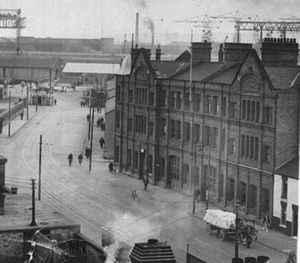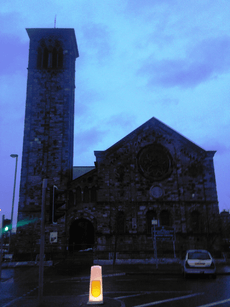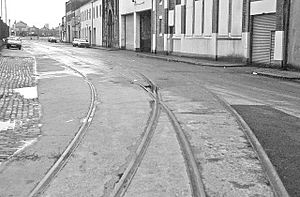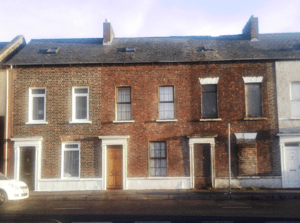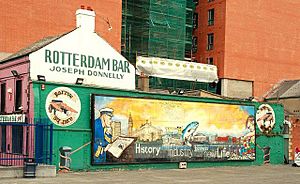Sailortown (Belfast) facts for kids
Sailortown was a busy community in the docks area of Belfast, Northern Ireland. It was a place where many working-class families lived. Sailortown started in the mid-1800s on land that was partly built up from the sea. People from both Protestant and Catholic backgrounds lived there.
In 1907, a big dock strike began in Sailortown. It was led by a union leader named James Larkin. This strike then spread across the whole city. Over time, in the late 1960s, Sailortown was mostly taken down to make way for new developments. Today, only a few old buildings remain from this once lively area. However, new homes are now being built there, and more people are moving back.
A "sailortown" is a special area in a seaport. It is designed to serve sailors who are visiting from other places. Many seaports around the world have had their own sailortowns.
Contents
Exploring Sailortown's Location
Sailortown is located in the Docks area. This is just north of Belfast city centre. It is surrounded by streets like Henry Street, York Street, and the Whitla Street dock gate. It was also very close to the old York Road railway station.
Garmoyle Street was the main road in Sailortown. Long ago, more than 5,000 people lived in this small area. Their homes were red-brick houses packed between the docks and York Street. Sailors from many countries visited, including those from Europe, India, and China. They added to the mix of Protestant and Catholic residents.
Many people from all over Ireland also came to Sailortown. Some arrived after losing everything during the Great Famine. In the late 1800s, many Italian immigrants settled nearby. This area was known as "Little Italy."
Two important churches served the people of Sailortown. One was the Sinclair Seamen's Presbyterian Church, which had a sea theme. The other was St. Joseph's Chapel, a Catholic church. Both churches are still standing today. St. Joseph's, built in 1880, closed in 2001. However, people are now working to fix it up, and it sometimes opens for special events.
The Midlands Hotel, near Sailortown, was once a very fancy hotel. Famous guests like Laurel and Hardy stayed there.
Sailortown's Past and People
Sailortown was Belfast's first waterfront village. It was built in the mid-1800s when Belfast's industries were growing fast. An 1845 map of Belfast already showed Sailortown. Besides the docks and warehouses, Sailortown had linen mills and factories. It also had a large fire station, a hotel, and many shops and pubs. Later, boxing clubs and cinemas were added.
Many local men worked as dockers, moving goods on and off ships. Others were carters, driving horse-drawn carts. Some became merchant seamen, traveling the world. Women often worked in the mills and cigarette factories. Many families had men, even boys as young as 14, away at sea. At its busiest, over 2,000 men worked in the docks. Goods were moved constantly by horses and carts near the railway station.
Life was tough for most people in Sailortown. They worked long hours for low pay. Their homes were often small, damp, and old. Sometimes, more than one family lived in a single house. Because of these hard conditions, Sailortown became a strong center for trade unions. These unions helped workers get better rights.
In 1907, James Larkin came to Belfast. He wanted to organize the dock workers into a union. He successfully brought both Protestant and Catholic dockers and carters into the union. In May 1907, he called for a strike. Workers wanted higher wages, better conditions, and their union to be recognized. The strike quickly spread. Transport workers, coal workers, and factory workers joined in. The strike lasted until August 28. It didn't fully succeed, and the army was called in. However, it led to Larkin starting a new, bigger union.
People from different backgrounds often lived side-by-side in Sailortown. They shared workplaces and sometimes even houses. However, the 'upper' part of Sailortown was mostly Protestant. The area closer to the Catholic church was mostly Catholic. Even with many foreign sailors visiting, Sailortown was a close community. They were often wary of strangers.
Sailortown was damaged during the Second World War. German planes bombed Belfast in 1941, targeting the docks. Many buildings in Sailortown caught fire. The docks were hit, and a large spinning mill was destroyed.
Sailortown's Changing Landscape
In the late 1960s, Sailortown began to change. Many homes were torn down to build the M2 motorway. The people who lived there had to move to new areas. The last old houses on Ship Street were removed in the 1970s. Today, only three original houses remain.
The Docks area has been rebuilt a lot. The "Rotterdam Bar," an old pub, was once a popular place for live music. It was planned to be torn down, but that didn't happen. The bar has been closed since the early 2010s.
A group called the Sailortown Cultural and Historical Society started in 1999. They work to preserve the history of the area. Since the early 2000s, new houses and apartments have been built. This is part of a plan to bring life back to Sailortown. St. Joseph's church is also being fixed up and used for community events.
Sailortown in Books and Songs
Sailortown has inspired many artists and writers. John Campbell, who grew up in Sailortown, has written poems about it. Two of his books, Corner Kingdom and The Disinherited, are set in the Docks. The Disinherited talks about how jobs were given out at the docks during World War II.
Playwright Martin Lynch wrote a play called Dockers in 1981. It shows what life was like in Sailortown in the early 1960s. The play focuses on how hard it was to get jobs and how powerful the union was in deciding who got hired.
Irish artist Terry Bradley has painted many pictures of the dockers from Sailortown.
Northern Irish singer/songwriter Anthony Toner wrote a song called "Sailortown." He wrote it after performing at the Rotterdam Bar. You can find this song on his album A Sky For Every Day.


